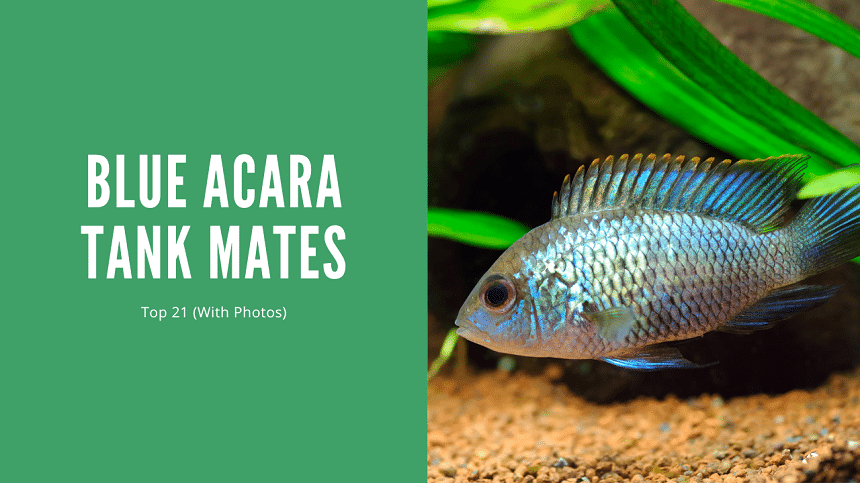Thank you for visiting! By the way… any links on this page that lead to products on Amazon and other stores/partners are affiliate links Aquarium Store Depot earns a commission if you make a purchase.
Have you ever admired the mesmerizing beauty of an Electric Blue Acara and wondered which other colorful fish could share its tank? Ensuring compatibility between tank mates is crucial to maintaining a harmonious and healthy aquarium. In this blog post, we’ll explore 21 great Blue Acara tank mates, along with tips for creating a thriving aquatic environment that both you and your fish will love.
Key Takeaways
- Blue Acaras are semi-aggressive, medium-sized cichlids with carnivorous diets.
- Due to their size, many potential tankmates exist, such as Angelfish to Convict Cichlids!
- Create a harmonious environment by providing plenty of space and hiding spots.
Understanding Them
Electric Blue Acaras, originating from South America and a part of the cichlid family, are exquisite tropical fish admired by aquarists worldwide1. Growing to around 6-8 inches when fully matured, these blue acara beauties will be eye-catching to any aquarium setup if their specific needs for water parameters and tank mates are met. To ensure your electric blues remain happy in their new home, it is important that you get acquainted with all aspects pertaining to this wonderful species!
Their Characteristics
Blue Acaras are considered an ideal cichlid for community tanks and for aggressive tanks with the right tankmates. These freshwater fish typically measure 4-8 inches long and require a carnivorous diet that incorporates proteins such as bloodworms, brine shrimp, or tablets. They can make suitable inhabitants of community tanks if the tank mates are compatible with them. Due to their smaller size, more options exist for them than other cichlids.

When it comes to breeding, female Blue Acaras will usually lay 150-200 eggs, which take 2-3 days before hatching into fry. This is when extra attention needs to be paid to monitoring interactions between tankmates since territorial behavior may occur during this period whilst they protect their young Electric Blues.
It’s important when choosing tank mates to choose suitably sized specimens but also to factor temperament into consideration when selecting potential companions for your Blue Acara aquarium setup so as to keep everyone safe and happy! Feeding shouldn’t be a problem with tankmates. Just make sure the tankmates are big enough where they can consume live or frozen foods in larger qualities to keep everyone well fed.
Tank Requirements And Water Parameters
A tank with enough swimming area and places to hide among rocks and vegetation must be created for Blue Acaras in order to make a comfortable environment. This will give them security, help keep stress levels down, and ensure the tank has the peacefulness required of it as a community aquarium. A minimum 40 gallon tank is necessary for just the species, with 55 or a 60 gallon breeder being recommended.
This new 60 gallon breeder by Aqueon has the length and width of a 75 gallon tank, but at a shorter height. This is the most economical and effective 4 foot gallon tank for the saltwater hobby now.
This will allow for more spacing so other tankmates can live peacefully. pH should also be in the ranges of 6.5 – 8 pH with temperatures around 74 to 82 degrees Fahrenheit. Also, good substrates are fine sand or rounded gravel to resemble their natural habitat.
21 Best Blue Acara Tank Mates
Finding suitable tank mates for your Blue Acaras is essential to create a suitable aquarium habitat. Here are 21 fish species that can get along well with them and their key features – each featuring its own characteristics which must be taken into account when picking potential companions in order to ensure harmony between all inhabitants. We will have the following listed for each tankmate candidate:
- Scientific Name
- Adult Size
- Water Temperature Range
- Minimum tank size
- Care Level
- Diet
- Origin
- Swimming Level
1. Angelfish
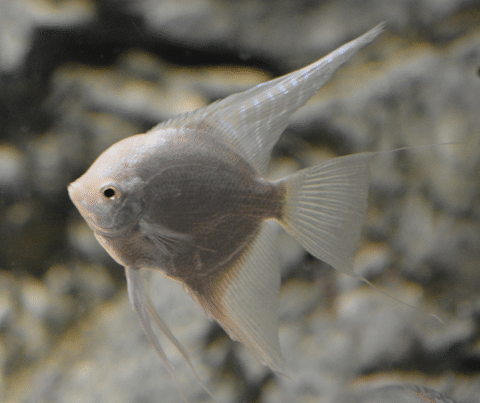
- Scientific Name: Pterophyllum scalare
- Adult Size: 4 to 6 inches
- Water Temperature: 75°F to 82°F
- Minimum tank size: 40 gallons
- Care Level: Easy
- Diet – Omnivore
- Origin – Amazon River
- Swimming Level – All
Angelfish, native to South America and of similar size/temperament to Blue Acaras, make great tank mates due to their charming looks & movement. Though they can be semi-aggressive at times – especially during breeding season – it is recommended that ample spots are accessible for them as a refuge from possible territorial aggression.
2. Corydoras Catfish

- Scientific Name: Corydoras spp.
- Adult Size: 2 to 3 inches, usually
- Water Temperature: 72°F to 79°F
- Minimum tank size: 10 gallons
- Care Level: Moderate
- Diet – Omnivore
- Origin – South America
- Swimming Level – Bottom of the tank
Corydoras Catfish are sociable creatures and enjoy living in groups of six or more. They remain quite peaceful when placed in the same tank as Blue Acaras, creating a calming aquarium atmosphere as they work to clean up the tank’s environment. These fish can come in various sizes and prefer soft sandy substrates to scavenge around. Maintaining their peace-seeking nature depends on providing enough companionship, so allocating space accordingly should be a high priority.
3. Roseline Sharks
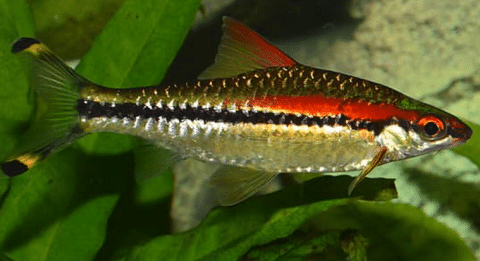
- Scientific Name: Sahyadria denisonii
- Adult Size: 4 inches
- Water Temperature: 60°F to 77°F
- Minimum tank size: 55 gallons
- Care Level: Moderate
- Diet – Omnivore
- Origin – India
- Swimming Level – Mid level
These schooling fish, Roseline Sharks, have a striking red and silver coloration. They make an eye-catching addition to any aquarium! These active creatures prefer being in groups and are usually more lively during the day. They can coexist peacefully with Blue Acaras if there is ample space for them, as well as plenty of greenery in the tank.
4. Silver Dollars

- Scientific Name: Metynnis argenteus / Metynnis hypsauchen
- Adult Size: 6 inches
- Water Temperature: 75°F to 82°F
- Minimum tank size: 75 gallons
- Care Level: Easy
- Diet – Omnivore
- Origin – South America
- Swimming Level – Mid level to top
Silver Dollars are a type of herbivorous fish from South America that are often kept with Blue Acaras, as they form peaceful groups in tanks, and their size is comparable. They have a distinctive disc-like shape, which makes them an excellent complement to the acara species. While they will get along with your Acara, if they are housed with live plants, they will likely consume them. They are best suited for a fish only environment as a result.
5. Blood Parrot Cichlid
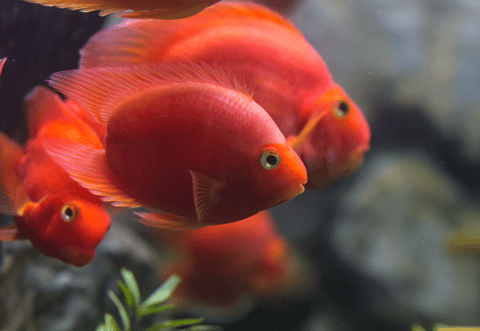
- Scientific Name: Hybrid
- Adult Size: 6 inches
- Water Temperature: 72°F to 82°F
- Minimum tank size: 55 gallons
- Care Level: Easy
- Diet – Omnivore
- Origin – Captivity
- Swimming Level – All levels
For those looking for compatible tank mates with their Blue Acaras, Blood Parrot Cichlids make an ideal choice. Having a gentle disposition and unique look, they will fit in well if given plenty of places to hide and stable water conditions. Nevertheless, it’s crucial that one keep watch over them during any interactions as these cichlids may act out territorially during spawning periods.
6. Congo Tetra
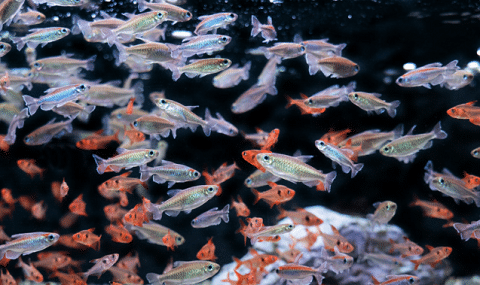
- Scientific Name: Phenacogrammus interruptus
- Adult Size: 2.5 – 3.5 inches
- Water Temperature: 73°F to 82°F
- Minimum tank size: 30 gallons
- Care Level: Moderate
- Diet – Omnivore
- Origin – Democratic Republic of Congo
- Swimming Level – Middle to Top
Due to their size and serene demeanor, congo tetras can be happily housed with blue acaras in an aquarium. For optimal health, it’s important for the fish to stay in groups, thus, a sizable tank furnished with plenty of plants would provide ideal conditions. Be careful when choosing other inhabitants as more aggressive species could potentially damage the delicate fins of these peaceful creatures.
7. Geophages
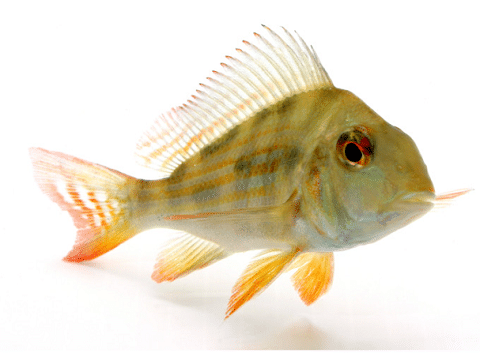
- Scientific Name: Geophagus spp.
- Adult Size: 5-8 inches
- Water Temperature: 76°F to 83°F
- Minimum tank size: 55-75+ gallons
- Care Level: Moderate
- Diet – Omnivore
- Origin – South America
- Swimming Level – Middle to Bottom
Geophages are mostly peaceful fish that can live in harmony with Blue Acaras. For them to peacefully coexist, it’s imperative to provide a proper habitat, one that offers plenty of space and sandy substrate for sifting, plus spots where they could find refuge like rocks or plants. To keep all the other species safe from potential risks while allowing geophages and acaras to share living environment, monitor their activity closely. Both creatures have an inclination towards rearranging things within the tank, which might cause distress among other fish if left unchecked.
A special breeding tank is also necessary when keeping these two types of fish together, as both species can get aggressive when breeding and housed in undersized tanks.
8. Clown Loach
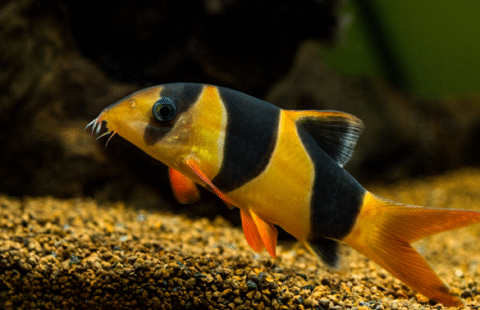
- Scientific Name: Chromobotia macracanthus
- Adult Size: 12 inches
- Water Temperature: 75°F to 86°F
- Minimum tank size: 100+ gallons
- Care Level: Moderate
- Diet – Omnivore
- Origin – Indonesia
- Swimming Level – Bottom
Clown Loaches are social and colorful fish that make great tankmates for Blue Acaras. They have very recognizable features, such as vibrant stripes of orange, black, and white. A slender body shape with antennae-like barbels near their mouth area. These traits, plus the fun behaviors they show in an aquarium, make them popular among aquarists alike who want to add life and color to their tanks!
Keeping Clown Loaches is even more enjoyable if kept in groups of five or higher – it increases their chances of having healthy relationships while also being contented themselves. This should be considered when pairing these amazing creatures with other species like Blue Acara so everyone can swim peacefully together.
Keeping clown loach pairs along with blue acara fishes creates gorgeous combinations not only aesthetically but also engaging since both demonstrate sociable natures yet remain charmingly unique from each other, making your entire aquarium one special treat to look out for!
9. Synodontis Catfish
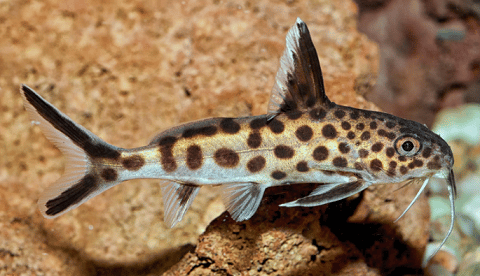
- Scientific Name: Synodontis alberti
- Adult Size: 6 inches
- Water Temperature: 72°F to 82°F
- Minimum tank size: 30 gallons
- Care Level: Easy
- Diet – Omnivore
- Origin – Republic of Congo
- Swimming Level – Bottom
Native to Africa, Synodontis Catfish are peaceful creatures that make great additions to a community tank. Requiring little maintenance and compatible with Blue Acaras, these bottom-dwelling fish with a unique dorsal fin do best in tanks featuring soft substrates and plenty of hiding spots. When the right conditions are provided for them, they can live up to 10 years or more!
10. Severum

- Scientific Name: Heros severus
- Adult Size: 8 inches
- Water Temperature: 75°F to 84°F
- Minimum tank size: 55 gallons
- Care Level: Moderate
- Diet – Omnivore
- Origin – South America
- Swimming Level – Bottom to mid
Severums are a suitable option for tank mates with Blue Acaras due to their similar size and mild temperament. Such companionship between the two species can live in tranquillity as long as there is adequate space dedicated solely for hiding purposes. This would enable them to evade any territorial disputes which may erupt otherwise. To maintain peace among these peaceful fish, providing many places where they could retreat will help ensure that the Severums get along with Blue Acaras harmoniously within one environment.
11. Uaru Cichlids
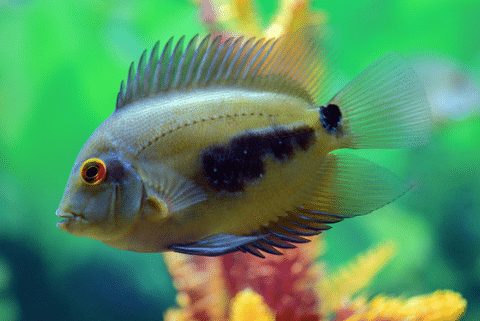
- Scientific Name: Uaru amphiacanthoides
- Adult Size: 10 inches
- Water Temperature: 80°F to 84°F
- Minimum tank size: 70 gallons
- Care Level: Moderate
- Diet – Herbivore
- Origin – South America
- Swimming Level – Bottom to mid
Uaru Cichlids are serene, herbivorous fish that can live in harmony with Blue Acaras but may demonstrate defensive behavior. Give them a spacious and planted aquarium containing hidey-holes like rocks or crevices to guarantee their peaceful coexistence. For these aquatic creatures, a tank that is sizable and has a pH at 6.5 – 7.5 will provide for ideal conditions.
12. Bala Shark
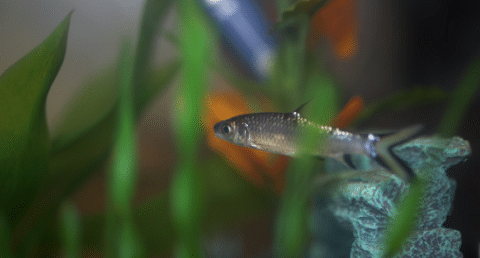
- Scientific Name: Balantiocheilos melanopterus
- Adult Size: 14 inches
- Water Temperature: 75°F to 82°F
- Minimum tank size: 125 gallons
- Care Level: Moderate
- Diet – Omnivore
- Origin – Southeast Asia
- Swimming Level – Mid to top level
Bala Sharks are incredibly desirable due to their exotic look and peaceful nature, making any tank a soothing environment. This type of fish needs an ample amount of room so they can be active. With appropriate hiding places for Blue Acaras in the same aquarium as well. These vibrant species not only require plenty of open swimming areas, but also thrive under these conditions, creating a unique ecosystem full of life that glimmers delightfully.
13. Firemouth Cichlids

- Scientific Name: Thorichthys meeki
- Adult Size: 5 to 6 inches
- Water Temperature: 75°F to 86°F
- Minimum tank size: 40 gallons
- Care Level: Easy
- Diet – Omnivore
- Origin – Central America
- Swimming Level – Mid to bottom
When housing Firemouth Cichlids together with Blue Acaras, a spacious tank is required to provide enough space for swimming and creating hiding spots. Such a setup allows similar-sized fish species to coexist and maintain harmony in the aquarium peacefully. When these two types of cichlids spawn, they may become aggressive towards each other, so monitoring their interactions closely is important. To make sure your tank mates live harmoniously, it’s necessary that you create comfortable living conditions, plenty of room for maneuverability, as well as hideaways.
14. Jack Dempsey Cichlid

- Scientific Name: Rocio octofasciata
- Adult Size: 10 inches
- Water Temperature: 75°F to 86°F
- Minimum tank size: 55 gallons
- Care Level: Intermediate
- Diet – Omnivore
- Origin – Central America
- Swimming Level – All levels
Jack Dempsey Cichlids and Blue Acaras can live together, but caution is needed as the former may show signs of aggression. To have a peaceful atmosphere in an aquarium with these fish, it’s important to provide adequate hideaways and space for them both while keeping watch over their interactions.
15. Medium Sized Gouramis

- Scientific Name: Trichopodus spp.
- Adult Size: 4-5 inches
- Water Temperature: 75°F to 82°F
- Minimum tank size: 30 gallons
- Care Level: Intermediate
- Diet – Omnivore
- Origin – Southeast Asia
- Swimming Level – Mid to top
These gentle fish, with their lovely colors, can cohabitate harmoniously in an aquarium alongside the Blue Acara, but should be removed from tanks containing hostile varieties. To ensure they flourish, provide them with a capacious and vegetation-rich abode brimming with secluded places for refuge. Your best option would be a Gourami fish like a Pearl Gourami.
16. Rainbowfish
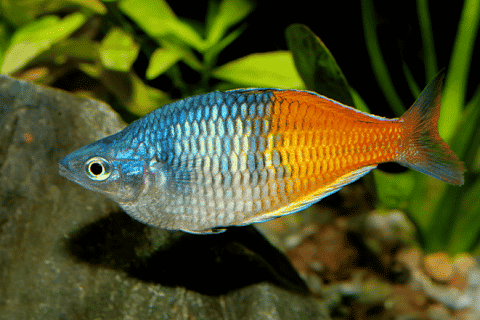
- Scientific Name: Melanotaenia boesemani
- Adult Size: 4-5 inches
- Water Temperature: 72°F to 77°F
- Minimum tank size: 40 gallons
- Care Level: Intermediate
- Diet – Omnivore
- Origin – Indonesia
- Swimming Level – Middle
Rainbowfish are known for their vivid colors and peaceful demeanor, making them an ideal choice to keep in the same aquarium as Blue Acaras. The presence of these active creatures will add a stunning flair to any tank they inhabit as long as it provides enough swimming space where they can thrive. Make sure your aquatic home has lots of areas open for movement so that Rainbowfish live comfortably inside it. They need to be a group of at least 6 and their larger size keeps them from being targets for the Acara.
17. Bristlenose Pleco
The Bristlenose Pleco is a smaller Pleco that does a great job of eating algae. Peaceful and gets along with most fish
- Scientific Name: Ancistrus Cirrhosus
- Adult Size: 4-5 inches
- Water Temperature: 73°F to 80°F
- Minimum tank size: 30 gallons
- Care Level: Easy
- Diet – Herbivore
- Origin – Amazon
- Swimming Level – Bottom
Peaceful bristlenose plecos make an attractive addition to any aquarium, given their unique appearance. They require enough space and places where they can hide, as these fish are not territorial. These algae-eaters cohabit with the Blue Acaras quite nicely in a spacious tank that offers some concealed areas for them to thrive better.
18. Zebra Loach

- Scientific Name: Botia Striata
- Adult Size: 3.5 inches
- Water Temperature: 73°F to 79°F
- Minimum tank size: 30 gallons
- Care Level: Easy
- Diet – Omnivore
- Origin – India
- Swimming Level – Bottom
These peaceful fish, with their distinct looks, provide an attractive addition to any home aquarium. Zebra Loaches are compatible companions for Blue Acaras and need ample room as well as plenty of hiding spots in order to thrive. Water conditions should also be steady within the tank environment.
19. Pictus Catfish

- Scientific Name: Pimelodus pictus
- Adult Size: 3 – 5 inches
- Water Temperature: 75°F to 82°F
- Minimum tank size: 75 gallons
- Care Level: Intermediate
- Diet – Omnivore
- Origin – South America
- Swimming Level – Bottom
For those looking for an attractive addition to their aquarium, the Pictus Catfish is a great choice. They have unique physical characteristics and active personalities, which make them excellent tank mates for Blue Acaras! They need to be great in groups as they like the company of their own kind. When providing these peaceful fish a home, be sure to supply plenty of space as well as hiding spots in order for them to thrive.
20. Giant Danio

- Scientific Name: Danio aequipinnatus
- Adult Size: 4 inches
- Water Temperature: 72°F to 75°F
- Minimum tank size: 30 gallons
- Care Level: Easy
- Diet – Omnivore
- Origin – India
- Swimming Level – All
A peaceful, eye-catching schooling fish, Giant Danios can easily be kept with Blue Acaras in a spacious and abundantly planted aquarium. As active swimmers, they require sufficient free swimming areas to feel comfortable. Their calm temperament serves as an asset for creating a serene underwater landscape. The exotic physical features of these impressive creatures will add beauty to any tank environment! This is the only danio species we recommended as others could be too small and may be eaten.
21. Convict Cichlid

- Scientific Name: Amatitlania nigrofasciata
- Adult Size:
- Water Temperature: 74°F to 84°F
- Minimum tank size: 30 gallons
- Care Level: Easy
- Diet – Omnivore
- Origin – South America
- Swimming Level – Midwater
Convict Cichlids are a cichlid that can dwell with Blue Acaras. They may demonstrate some territorial tendencies, but both are around the same size where they usually will not battle. Make sure the aquarium provides several havens for hiding and carefully monitor the interactions. Convicts are known to be aggressive when breeding – and these species of cichlids are known for breeding often!
Tips For Creating A Harmonious Aquarium
For a successful aquatic setup with your Blue Acaras and their tank mates, it’s important to gain knowledge on compatible species as well as individual needs. Tank size is your biggest factor. The larger the tank, the higher the chances of success. The more shelter you have will also help in curbing aggression.
When mating occurs, keep watch over other occupants’ interactions because conflict levels may escalate. It is not uncommon for a hobbyist to keep a single Acara as a centerpiece fish. This removes the risk of aggression when breeding.
Frequently Asked Questions
What fish can you put with blue Acara?
When looking for suitable companions to keep with the Blue Acara, it’s best to research which are optimal before making a decision. Those could include angelfish, plecos, medium sized gouramis, and corydoras catfish. Creating an ideal tank environment that works well for all involved will help ensure they thrive together happily. Avoid large aggressive fish or extremely territorial fish that could bully them to death.
Is Electric Blue Acara a community fish?
Electric Blue Acaras are ideal for some community fish tanks due to their amiable nature and hardy constitution. These fish don’t grow too large either, only reaching a maximum size of 6 inches, making them an excellent choice if your tank in medium sized tanks. However, they are a risk to small nano fish that could be eaten by them. It’s best to house them with either medium sized fish or fish larger than them that are peaceful.
What size tank for a pair of blue acara?
A minimum of 45 gallons should be provided for a pair of Blue Acara, 30 gallons as the initial requirement, and then an additional 15 gallon per extra fish.
How big do Blue Acaras grow?
Blue Acaras usually grow to be between 4-6 inches. They are considered a medium sized fish in the hobby.
How can I create a harmonious aquarium for my Blue Acaras and their tank mates?
When selecting tank mates for your Blue Acaras, do the necessary research to ensure they are compatible. Make sure there are sufficient hiding spots available in the aquarium, and continually observe their behavior to maintain peace. This will help make sure that your new fish have an enjoyable stay in their habitat.
Closing Thoughts
Creating the perfect habitat for your Blue Acaras means carefully selecting their tank mates. Paying attention to interactions and ensuring adequate hideaways will ensure that both species inhabit a thriving aquatic space filled with peace, vibrancy, and contentment. Every day, you can find joy in admiring the unique beauty of this harmonious ecosystem you have created!
Have you tried to keep a Blue Acara in your aquarium? If so, let us know your experience in the comments below. We enjoy hearing from our readers. Until next time!
- About the Author
- Latest Posts
I’m thrilled that you found Aquarium Store Depot! Here you’ll find information on fish, aquariums, and all things aquatics related. I’m a hobbyist (being doing this since I was 11) and here to help other hobbyists thrive with their aquariums! I adhere to a high quality Editorial Process and Review products with real life field usage and practical analysis.

